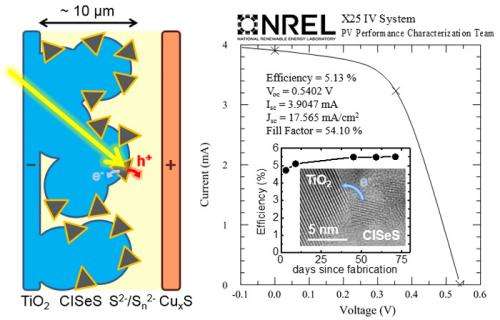Nontoxic quantum dot research improves solar cells

Solar cells made with low-cost, nontoxic copper-based quantum dots can achieve unprecedented longevity and efficiency, according to a study by Los Alamos National Laboratory and Sharp Corporation.
"For the first time, we have certified the performance of a quantum dot sensitized solar cell at greater than 5 percent, which is among the highest reported for any quantum dot solar cell," said Hunter McDaniel, a Los Alamos postdoctoral researcher and the lead author on a paper appearing in Nature Communications this week. "The robust nature of these devices opens up the possibility for commercialization of this emerging low-cost and low-toxicity photovoltaic technology," he noted.
The reported solar cells are based on a new generation of nontoxic quantum dots (not containing either lead or cadmium as do most quantum dots used in solar cells). These dots are based on copper indium selenide sulfide and are rigorously optimized to reduce charge-carrier losses from surface defects and to provide the most complete coverage of the solar spectrum.

"The new solar cells were certified by the National Renewable Energy Laboratory (NREL) and demonstrated a record power-conversion efficiency for this type of devices," according to Victor Klimov of Los Alamos, director of the Center for Advanced Solar Photophysics (CASP), a DOE Energy Frontier Research Centers (EFRC). In addition to CASP-EFRC, this research has been also supported via a cooperative research agreement with Sharp Corporation.
More information: The paper, "An integrated approach to realizing high-performance liquid-junction quantum dot sensitized solar cells" is scheduled for online publication in Nature Communications on Dec. 10, 2013.
Journal information: Nature Communications
Provided by Los Alamos National Laboratory



















